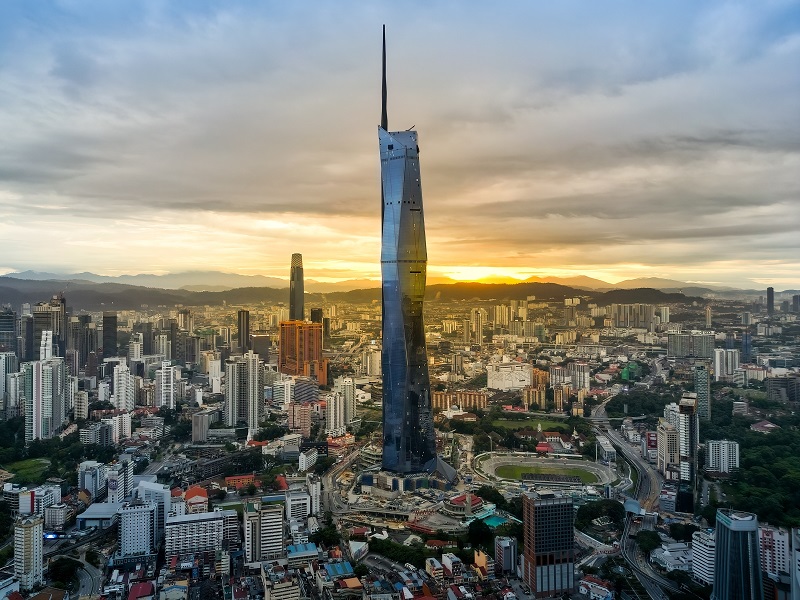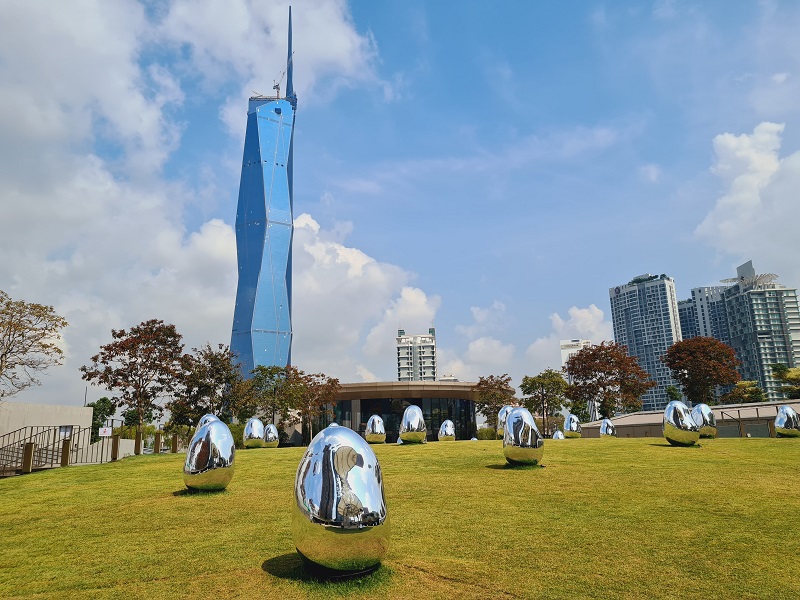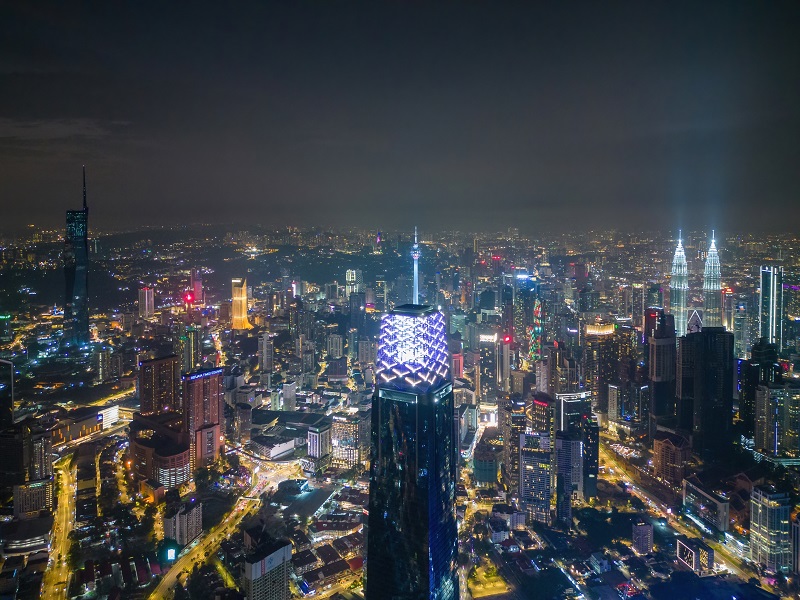Merdeka 118 is a 118-storey mixed-use tower being developed in Kuala Lumpur, Malaysia. With a height of 678.9m, it is expected to become the tallest building in Malaysia and Southeast Asia and the second tallest in the world.
The project was earlier known as Menara Warisan Merdeka, KL 118 and PNB 118. It is being developed by PNB Merdeka Ventures, a wholly-owned subsidiary of Permodalan Nasional Berhad (PNB), with an estimated investment of $1.5bn. It is expected to be completed by 2026.
Merdeka 118 location
Merdeka 118 is located between the transport hub in KL Sentra and the TRX precinct near the Merdeka Stadium in Jalan Hang Jebat, Kuala Lumpur.
The tower is connected to the Merdeka mass rapid transit (MRT) station and provides easy access to the MRT, light rail transit and expressway networks.
Merdeka 118 tower details
The Merdeka 118 tower is a 3.1 million ft² mixed-use development comprising office space, a hotel, a shopping mall, an observation deck and several other amenities.
It will offer one million square feet of grade-A office space accommodating 16,000 employees across 83 floors.
A six-star Park-Hyatt hotel will be on the top 16 floors of the tower from the 97th to the 112th floors. The hotel will offer 230 guest rooms and a rooftop restaurant.
The top of the tower will feature a two-level 360° observation deck with glass floors and external glass elevators. It will provide a panoramic view of the city’s skyline.
The first to seventh floors of the tower form the common podium of the building and comprise a shopping mall offering one million square feet of retail space. The shopping mall will feature 328 stores, a promenade, a food court and entertainment options. It will connect to the Merdeka 118 tower with the accompanying smaller residential towers.
The remaining 18 floors of the tower will comprise mechanical and electrical plants, ancillary and support spaces, a destination restaurant and sky lobbies. Car parking will be provided on four basement levels.
Merdeka 118 tower structure and design details
Merdeka 118 features an external steel structure supported by a reinforced concrete megastructure that offers lateral stability. The megastructure features mega-columns at the perimeter that are connected to the central structure through structural steel outriggers at three locations. Belt trusses are used to support the megastructure and render improved strength to the tower.
The tower’s external design incorporates a robust, multi-faceted diamond structure encompassing varying arrays and sizes of triangular glass panels, which align with the structure’s bracing lines. The triangular facets or panels are inspired by the designs found in the traditional Malaysian songket materials and represent the country’s rich culture.
The tower features an innovative 120m-high perforated steel-clad spire at the top of the building that moderates wind pressures. The flexible and slender spire accounts for a quarter of the tower’s height and vibrates when exposed to wind load. A 3D truss frame with 30% porosity was adopted in the spire’s facade to minimise the wind load and reduce wind-induced vibration on the spire.
The exterior design elements are reflected in the interior spaces as well within the 30m-high central reception lobby featuring traditional Malay Minangkabau architecture.
The arrival point to the building is integrated with a 15m-high canopy featuring three car lanes and two bypass lanes with an easy drop-off for the people entering the building. High-speed double-deck shuttles and local elevators provide access to various floors of the tower.
Other developments
The project also includes the development of three residential towers within the site, with 800 apartments and a four-acre linear park at the foot of the tower known as the Merdeka Boulevard at 118.
A textile gallery, a 1,000-seat theatre, a 2,000-capacity ballroom, two heritage stadiums, a masjid with a capacity of 3,000 people and a cafe named Look at 118 are also being developed.
Merdeka 118 construction
The mixed-use project is being built in phases. The first phase encompasses the 118-storey tower and infrastructure for the surrounding area.
The tower was topped out in June 2021, while the spire was completed in November 2021.
The second phase involves the mall and linear park, while the final part of the development includes the residential towers.
Sustainability features
The tower incorporates sustainability features aimed at achieving Leadership in Energy and Environmental Design, Green Real Estate and Green Building Index certifications. PNB Merdeka Ventures also plans to secure WELL certification [an international system that measures, monitors and certifies a series of features to promote occupant wellbeing] for the office space.
The exterior glass facade integrates low E [low emissibility]-coating and titanium coating that will effectively reduce ultraviolet rays and heat inside the building, while natural light helps reduce the overall energy consumption.
The interior floors feature flexible under-floor air conditioning enabling optimal circulation of air and boosting energy efficiency. Other energy-efficient features include daylight sensors, automatic blind controls and centralised district cooling with an on-site chilled water energy storage in the basement that can store 35,000m³ of chilled water.
Contractors involved
The Merdeka 118 tower was designed by Fender Katsalidis Architects, an architecture firm based in Australia, while RSP Architects Planners & Engineers, an architectural and engineering design group based in Singapore, served as the local architect.
Robert Bird, a consulting engineering company, and Leslie E Robertson Associates, a structural engineering company, were the structural engineers for the project. Arup, a professional services company, provided structural and civil engineering, geotechnical engineering and geotechnics services.
Turner International, a project management and construction management consultancy services provider, was appointed as the project management consultant.
A joint venture of Samsung C&T, a construction and engineering company based in South Korea, and UEM, an engineering-based infrastructure and services provider, are the main contractors for the project. Eversendai, a construction company based in Malaysia, is the subcontractor.
Barker Mohandas, a vertical transportation consulting company, Terrapin Bright Green, a sustainability consultancy, RWDI, an engineering consultancy, Sasaki, a landscape architecture firm, Thornton Tomasetti, an engineering consultancy, and Kaer, a built environment specialist, are some of the other contractors involved.
Suppliers involved are Permasteelisa, an architectural envelopes and interior systems supplier, KONE, a provider of elevators and escalators, Doka, a formwork supplier, and ArcelorMittal, a steel manufacturing company.






